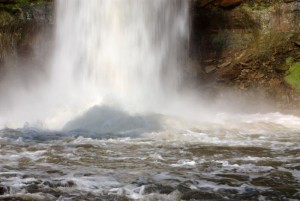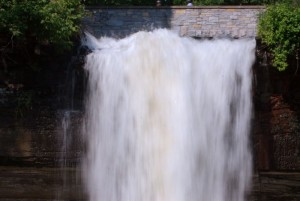Having started photography before automation was the norm, I had to learn how to use a light meter and set exposure by brute force right up front.
I’ve always wondered what the process of transitioning from automatic to manual exposure was like (hordes of people make the transition, despite the widely-expressed belief in the 1980s that if you started out with an automatic camera you never really could; even at the time that sounded like dinosaur talk to me).
I’m a “how this works and how it developed” kind of learner. People with drastically different learning styles may very well not find the following information useful; there may be too much of it, and it may not be focused specifically enough on what they need to know right now. I can answer that kind of question too, but when writing explanations in general I tend towards excessive information.
There are three controls on the camera that affect exposure (ignoring flash).
The “ISO” is the sensitivity of the digital sensor (or film; same units are used). (One of the great benefits of digital is that I can change ISO from shot to shot, without having to change film (which mostly comes in rolls, so changing in the middle of a roll means either wasting some, or doing a lot of finicky manipulations and marking and risking accidental multiple exposures)). Bigger numbers mean more sensitivity meaning the picture will be brighter (and noisier), all other things being equal.
The “shutter speed” is the amount of time that the film/sensor is exposed to the light coming through the lens. It’s measured in ordinary time units — 1/60 second, 1/1000 second, and so forth. More time lets in more light, and makes the picture brighter, all other things being equal. (Faster shutter speeds will “freeze” faster motion. Slower shutter speeds will blur motion, including any camera shake.)
The “aperture” is an adjustable diaphragm buried in the middle of the lens that controls how much light is let through. It’s measured in a weird unit — “f stops”. (The f number is the ratio of the focal length of the lens to the diameter of the opening in the diaphragm, so it’s a pure dimensionless number.) What it’s good for is that “f/8” on a 50mm lens puts exactly the same amount of light on the sensor that f/8 on a 400mm lens does. This is much more convenient than having to figure exposure differently for each different focal length lens (especially today with zoom lenses being the norm). Bigger numbers let through less light, making the picture darker (all other things being held constant). Smaller numbers let through more light, making the picture lighter.
To photographers, the “f/stop” is the basic unit we think of exposure in. And it doesn’t relate at all directly to the f-numbers used to measure aperture.
“One f/stop” means a doubling or halving of exposure. We’ll say “I need to give this another two stops exposure”, meaning we have to give it 4 times as much exposure (“two stops” means doubling twice, meaning a factor of 4). We can do this the obvious way with the shutter speed: give it 4 times as much time (go from 1/400 sec. to 1/100 sec., for example).
With the ISO, the way it works is that a doubling of the number represents a one-stop increase (doubling) of sensitivity; so we could give the shot two stops more exposure by changing from ISO 100 to ISO 400.
With the aperture, to increase exposure by two stops we cut the number in half — going from f/8 to f/4, for example. Yes, the numbers go the opposite direction from everything else; large f numbers give less exposure, small f numbers give more exposure. (To change aperture by one f/stop, you change the number by a factor of the square root of 2, which is about 1.4; this gives rise to the classic series of f numbers that experienced photographers have burned into their medulla: 1.4, 2, 2.8, 4, 5.6, 8, 11, 16, 22, 32.) Changing from f/2.8 to f/4 is giving one stop less exposure, and changing from f/32 to f/11 is giving two stops more exposure.
Photographers talk about the aperture itself, not the number; we will all say that f/11 is a “smaller aperture” than f/8, and that f/2 is a “bigger” or “wider” aperture than f/5.6. With a manual enough lens, you can see the actual aperture adjusting inside the lens as you turn the aperture ring, and see that what we call “smaller apertures” are indeed smaller; unfortunately for learning, most lenses don’t have aperture rings any more. We will “stop down two stops” to go from f/8 to f/16, or “open up a stop” to go from f/5.6 to f/4.
I’m not AT ALL surprised that people coming to this for the first time find it somewhat confusing. It’s one of those highly-evolved systems from the past with strange terminology. It actually works very neatly in practice, but it’s hard to explain without producing gibbering insanity at least the first few times.
But it could be worse; we could be representing film/sensor sensitivity using the DIN system, which is logarithmic (a difference of 3 in the DIN number represents a one-stop change in sensitivity). In fact it might be better if we were; the range of ISOs that we have to deal with in modern cameras goes from at least 50 to 25,600.
“Equivalent exposures” is a vital concept. If you make equal but opposite changes in two of the factors affecting exposure, the net result will be the same (picture will be equally light/dark). (With digital, in the useful ranges, this is basically true; with film there was something called “reciprocity failure” where at very long or very short shutter speeds this principle, called the reciprocity law, did not hold.) (All three controls affect exposure AND have other effects; the other affects change as normal. So we can deliberately adjust the shutter speed to get the degree of blurring/freezing we want, and compensate with the aperture and/or ISO to get the same exposure.)
So, given a starting exposure of ISO 100 1/100 sec. f/8, all of the following are equivalent to it (and to each other):
| ISO | Shutter | Aperture |
|---|---|---|
| 100 | 1/100 | f/8 |
| 100 | 1/200 | f/5.6 |
| 100 | 1/400 | f/4 |
| 100 | 1/800 | f/2.8 |
| 100 | 1/1600 | f/2 |
| 100 | 1/50 | f/11 |
| 100 | 1/25 | f/16 |
| 200 | 1/400 | f/5.6 |
| 200 | 1/800 | f/4 |
| 200 | 1/1600 | f/2.8 |
| 200 | 1/200 | f/8 |
| 200 | 1/100 | f/11 |
| 200 | 1/50 | f/16 |
| 400 | 1/800 | f/5.6 |
| 400 | 1/1600 | 4/3 |
| 400 | 1/400 | f/8 |
| 400 | 1/200 | f/11 |
| 400 | 1/100 | f/16 |
(Typed that manually, so I suppose the odds of a grotesque screw-up are pretty good.)
Now, a couple of useful rules of thumb:
The “sunny 16 rule”: The right exposure for a subject in direct sun is roughly a shutter speed of 1/ISO at an aperture of f/16 (or any equivalent exposure). So at ISO 400, 1/400 sec. at f/16 is about right.
This one is very rough, but for most people the slowest shutter speed at which they can hold the camera steady enough not to get visibly blurred pictures is 1/(35mm-equivalent lens focal length). People differ a lot, but the principle that it scales with focal length is reliable; that’s just physics (or geometry) (it’s actually scaling with magnification). (This doesn’t consider subject motion; the speed that keeps camera shake from being a problem may still not be fast enough to freeze a moving subject.)
So, what’s the right exposure? That’s an artistic question, and hence totally a matter of opinion; not a technical question. For many purposes, if it’s possible to get the entire brightness range of the scene recorded, that’s useful (or at least the entire brightness range excluding “specular highlights”, shiny bits that directly reflect the light source). When it isn’t, you need to decide which parts of the scene are necessary to record; and expose to do so. If you need more than your sensor can capture (increasingly rare), you can try taking multiple exposures at different exposures and combining them to make an “HDR” (high dynamic range) image.









